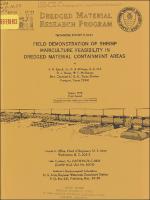Please use this identifier to cite or link to this item:
https://hdl.handle.net/11681/47134| Title: | Field demonstration of shrimp mariculture feasibility in dredged material containment areas |
| Authors: | Quick, J. A., Jr. Milligan, D. J. Hill, S. E. Hover, R. J. McIlhenny, W. F. |
| Keywords: | Shrimp culture--Texas Dredging spoil Dredged material |
| Publisher: | U.S. Army Engineer Waterways Experiment Station |
| Series/Report no.: | Technical Report (Dredged Material Research Program (U.S.)) ; no. D-78-53 |
| Abstract: | Dredging of the nation's waterways results in the production of large volumes of material that must be removed and disposed of. Much of this dredged material is disposed of in diked land disposal sites called dredged material containment areas (dmca). Since dewatering of the disposed sediments takes months or years, these dmca's remain nonproductive over long periods of time. This study was undertaken to determine the potential of shrimp mariculture in dmca's as a productive use of those sites.A 158-acre dmca located on the Gulf Intracoastal Waterway, near Freeport, Texas was chosen as the demonstration site. A manageable 20-acre pond area was isolated from the main containment area by an internal levee and used as the culture pond. The pond was filled with 50-micron-screened seawater pumped from the Intracoastal Waterway. To kill any predators present in the water, the pond was treated with 3 applications of an icthyotoxin. Commercial agriculture fertilizer was added to the pond to stimulate a phytoplankton bloom which served directly and indirectly as the sole food supply for the shrimp. No prepared food was provided to the shrimp during the experimental grow-out. The pond was stocked with 30-day-old "hardened" postlarval penaeid shrimp (Penaeus setiferus). Seven weeks later, average survival was estimated to be in the range of 86 to 93 percent and the average size of the shrimp sampled was 5.2 gm. (87 count, heads on). The harvest rate was estimated to average 185 to 200 pounds per acre. Several different harvesting techniques were tested, but unusually early cold weather prevented a complete harvest. Harvested shrimp were awarded a Certificate of Wholesomeness for human consumption by the U.S. Department of Commerce. No off flavors or other negative qualities were found in organoleptic testing of the shrimp. It was the conclusion of this study that it is both biologically and economically feasible to culture penaeid shrimp on a commercial scale in dredged material containment areas. |
| Description: | Technical Report |
| Gov't Doc #: | Technical Report D-78-53 |
| URI: | https://hdl.handle.net/11681/47134 |
| Appears in Collections: | Technical Report |
Files in This Item:
| File | Description | Size | Format | |
|---|---|---|---|---|
| Technical Report D-78-53.pdf | 12.54 MB | Adobe PDF |  View/Open |